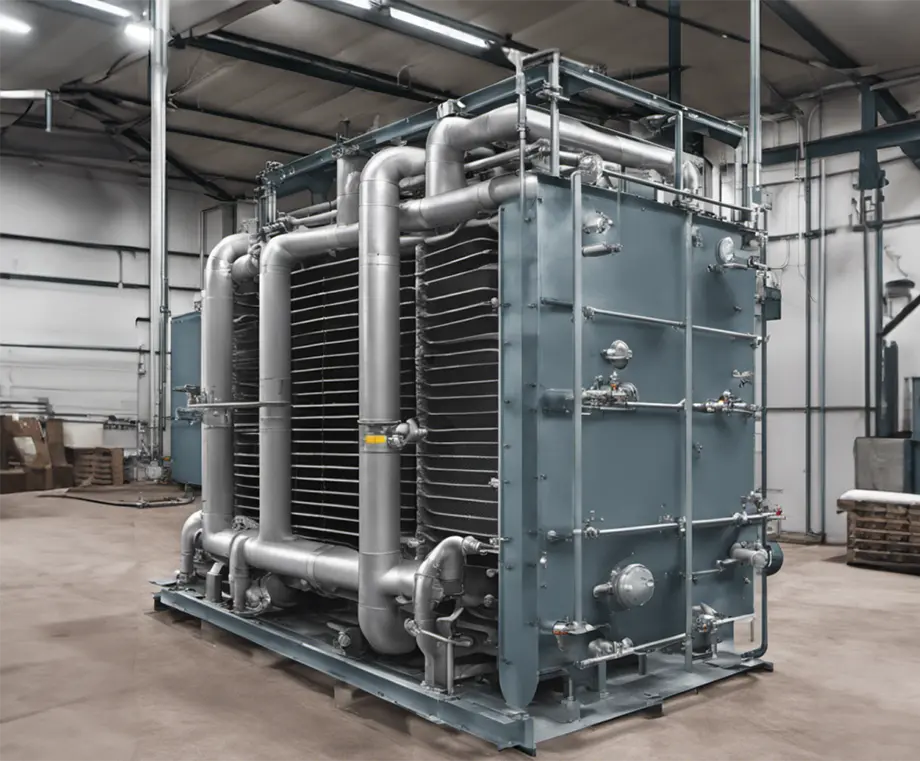As the world continues its journey toward sustainable practices, industries are constantly seeking innovative ways to optimize industrial processes, energy usage and reduce their environmental impact. For process engineers working at industrial manufacturers, one promising solution is the utilization of industrial heat pumps to upgrade recovered energy from waste heat. This technology holds the potential to not only improve energy efficiency but also contribute to emission control efforts. In this blog, we will explore the ins and outs of industrial heat pumps and how they can be harnessed to make the most of waste heat recovery.
Why are Industrial Heat Pumps important?
Most manufacturers realize they need to become independent from fossil resources and stimulate electrification to decarbonize industrial processes. In the realm of industrial manufacturing, the term “waste heat” has long been associated with inefficiency and lost potential. However, advancements in heat pump technology have provided a way to extract value from this waste heat by upgrading it into useful, higher-temperature heat. This process not only reduces the reliance on primary energy sources but also aligns with sustainability goals, making it an attractive proposition for process engineers. In short, manufacturers have the following reasons to integrate Heat Pumps in their Energy Recovery processes:
- Upgrading recovered (low grade) waste heat
- Large cost saving potential
- Proven & reliable technology with wide variety of applications
- Improving the overall efficiency of Heat Recovery System in combination with High Temperature Heat Pumps
- Clear CAPEX and considerable OPEX improvements
What is an Industrial Heat Pump?
Before delving into the specifics, let’s define what an industrial heat pump is. At its core, a heat pump is a device that transfers thermal energy from a lower-temperature source to a higher-temperature sink using mechanical work or a small amount of external energy. In the context of industries, an industrial heat pump takes waste heat at a relatively low temperature and “upgrades” it to a higher temperature, making it suitable for various applications within the manufacturing process.
A heat pump uses heat from a supplier (e.g. created from waste water from a scrubber or hot air / Process Heat from a dust collection system) from a lower temperature to a higher temperature. There is a wide variety of industrial heat pumps that makes it very attractive for multiple applications and consumers.
How does an industrial heat pump work?
To understand how industrial heat pumps upgrade recovered energy from waste heat, let’s delve into the fundamental workings of a heat pump system. At its core, an industrial heat pump operates on the same principles as a household refrigerator but in reverse. It transfers thermal energy from a low-temperature source to a high-temperature sink by utilizing mechanical work.

The basic components of an industrial heat pump system include:
- Evaporator: The evaporator is where the low-temperature waste heat source, such as exhaust gases or cooling water, interacts with a refrigerant or working fluid. The waste heat causes the refrigerant to evaporate, absorbing energy in the process.
- Compressor: The evaporated refrigerant is then compressed by a compressor. Compressing the gas increases its temperature and pressure, resulting in a high-temperature, high-pressure gas.
- Condenser: The high-temperature, high-pressure gas is passed through the condenser, where it releases heat to the high-temperature sink. This heat transfer causes the refrigerant to condense back into a liquid state.
- Expansion Valve: The condensed liquid refrigerant then passes through an expansion valve or throttling device. This expansion causes the refrigerant to rapidly cool and evaporate, which lowers its temperature and pressure, preparing it for the evaporator once again.
By cycling through these processes, the heat pump system continuously transfers heat from the waste heat source to the higher-temperature sink, upgrading the thermal energy along the way. This upgraded heat can then be used for various industrial processes that require higher temperatures, such as steam generation or industrial drying.
The ability of an industrial heat pump to upgrade waste heat lies in its ability to “pump” thermal energy against the natural temperature gradient. This process requires input energy, typically in the form of electricity to power the compressor. The energy gained from the waste heat is thus amplified and upgraded to a more valuable form, creating a net benefit in terms of energy utilization and efficiency.
In conclusion, an industrial heat pump is a sophisticated energy upgrading system that transforms low-temperature waste heat into high-temperature usable heat through a series of thermodynamic processes. By harnessing these principles, process engineers can maximize energy efficiency, reduce emissions, and contribute to sustainable industrial practices.
How to use Heat Pumps to upgrade industrial Waste Heat?
The process of upgrading industrial waste heat using heat pumps involves several key steps:
- Heat Source Identification: Identify sources of waste heat within the industrial process, such as exhaust gases, cooling water, or process streams. These sources should have a temperature gradient that makes them suitable for heat pump integration.
- Heat Pump Selection: Choose an appropriate heat pump system based on factors like the temperature difference between the waste heat source and desired output, as well as the required heat capacity. There are various types of heat pumps, including air-source, water-source, and geothermal, each with its own advantages and limitations.
- Heat Exchange and Upgrade: The heat pump system extracts thermal energy from the waste heat source using a refrigerant or working fluid. By applying compression and expansion cycles, the heat pump upgrades the energy to a higher temperature level, making it usable for specific industrial processes.
What are suppliers of Industrial Waste Heat?
Industrial waste heat can be found in various processes, including:
- Exhaust Gases: Energy-rich exhaust gases from combustion processes, such as those from boilers or furnaces.
- Cooling Water: Hot water used for cooling purposes in various industrial applications.
- Process Streams: Streams of fluids used in manufacturing processes, which can carry significant amounts of thermal energy.
Within the field of Emission Control, we often make use of the heated scrubbing liquid. See more Energy Recovery Scrubber or the hot air generated by Dust Collection Systems.
What is ‘Coefficient of Performance’ (COP) when using Heat Pumps?
The Coefficient of Performance (COP) is a crucial metric when evaluating the efficiency of a heat pump. It’s defined as the ratio of the upgraded heat output to the input energy required to run the heat pump. In other words, it’s the difference between total energy entering and leaving a system.
A higher COP indicates greater efficiency in utilizing waste heat for useful purposes. Engineers should consider COP when selecting and designing heat pump systems to ensure optimal energy savings.
When a heat pump has a COP value of 5, this means that the addition of 1 kW of electric energy is needed to have a release of 4 kW of heat at the condenser. At the evaporator side, 4-4,5 kW of heat is extracted. The additional heat is generated by the compressor.
WEBINAR
Optimization of your production processes is key in reaching the EU 2030 GHG targets. Manufacturing industries account for 26% of the total energy consumption within the EU. Almost half of this energy is lost!
What Refrigerants are used for Industrial Heat Pumps
When it comes to industrial heat pump systems, the choice of refrigerants plays a critical role in ensuring efficient and environmentally responsible operation. Refrigerants are substances used within the heat pump cycle to transfer heat from the low-temperature source to the high-temperature sink. However, it’s important to note that not all refrigerants are created equal in terms of their environmental impact.
In the past, many heat pump systems utilized Chlorofluorocarbons (CFCs) and Hydrochlorofluorocarbons (HCFCs) as refrigerants. These compounds, while effective in their heat transfer properties, posed a significant threat to the ozone layer and had high global warming potentials (GWP). In response to environmental concerns, there has been a global effort to phase out the use of such refrigerants.
Modern industrial heat pump systems primarily use hydrofluorocarbons (HFCs) and Hydrofluoroolefins (HFOs) as refrigerants. While these compounds have significantly lower ozone depletion potential compared to older refrigerants, they still have relatively high global warming potentials. As a result, there is a growing trend toward adopting low-global-warming-potential (low-GWP) and environmentally friendly refrigerants.
Natural refrigerants, such as Ammonia (NH3), Carbon Dioxide (CO2), and Hydrocarbons (propane, butane), are gaining traction in industrial heat pump applications due to their minimal impact on the environment. Ammonia, for instance, has excellent heat transfer properties and a negligible impact on global warming, making it a suitable choice for various industrial processes.
The selection of a refrigerant should consider factors like:
- Heat transfer efficiency
- Safety
- Environmental impact
- Regulatory compliance
Process engineers must weigh these factors carefully to ensure that the chosen refrigerant aligns with both performance and sustainability objectives. The choice of refrigerant for industrial heat pumps has a significant impact on the overall efficiency and environmental footprint of the system. As industries continue to prioritize sustainability, the adoption of low-GWP and natural refrigerants will likely become more widespread, contributing to a greener and more responsible approach to energy recovery and utilization.
High Temperature Heat Pumps
Most industrial Heat Pumps operate as chillers or medium-temperature Heat Pumps for hot water production. Steam generation would require higher temperature levels, which present both technical and practical challenges in the development of new Heat Pumps. One such challenge is the selection of a suitable refrigerant. See Figure below for typical temperature ranges of industrial Heat Pumps.

There are various players in the industry that are developing new technologies to enable Heat Pumps to operate at temperatures required for steam generation, and several of the more promising ones are revieved and suggested during Pre-Engineering Studies for multiple clients. Also read ‘Comparing the best suppliers of High Temperature Heat Pumps’ to learn more.
How are Heat Pumps related to Emission Control?
Heat pump integration not only enhances energy efficiency but also contributes to emission control efforts. By utilizing waste heat, manufacturers reduce the need for additional fossil fuel consumption, which in turn leads to a decrease in greenhouse gas emissions. This aligns with global sustainability goals and regulatory requirements, making heat pumps a valuable tool in the pursuit of greener manufacturing processes.
In conclusion, the utilization of industrial heat pumps to upgrade recovered energy from waste heat presents a promising avenue for process engineers in the industrial sector. By identifying waste heat sources, selecting appropriate heat pump systems, and optimizing the Coefficient of Performance (CoP), engineers can enhance energy efficiency, reduce emissions, and contribute to a more sustainable future for industrial manufacturing. As industries continue to evolve, integrating heat pump technology could be a pivotal step toward achieving both economic and environmental objectives.



